Chatbots vs Human Agents Advantages and Disadvantages Explained
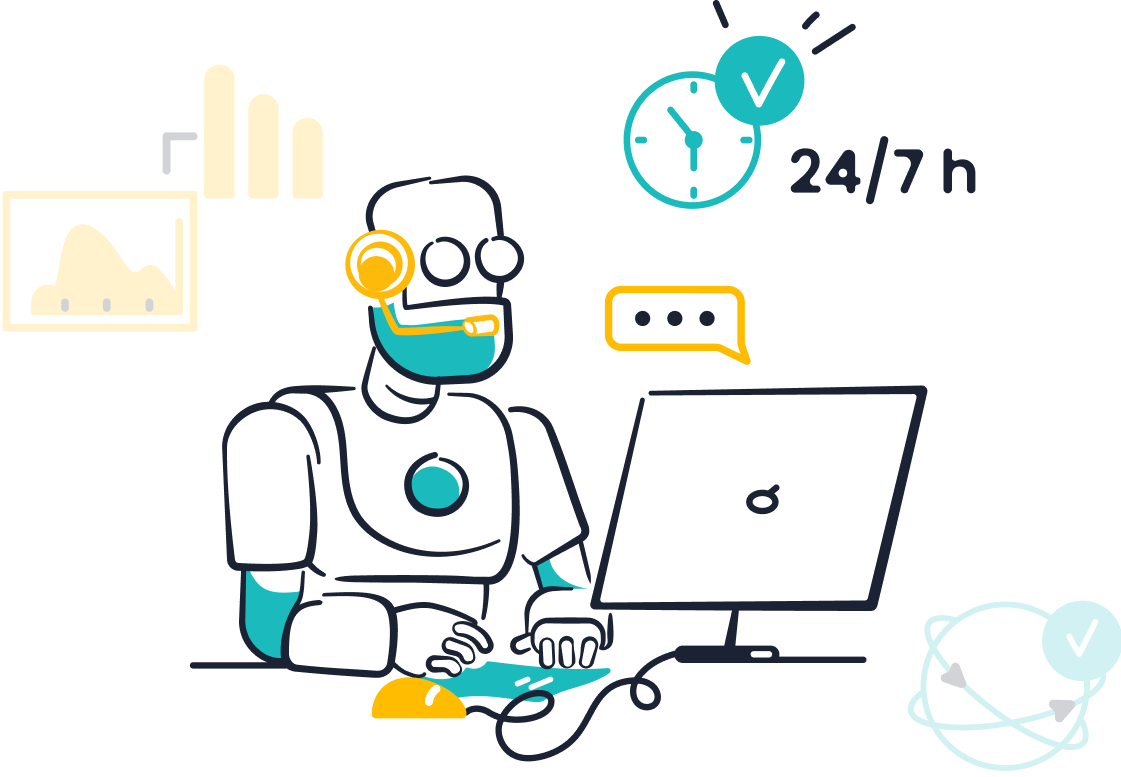
Both chatbots and human agents bring unique strengths and weaknesses to customer service. Chatbots offer speed, cost savings, and 24/7 availability, while human agents provide empathy and handle complex situations better. Recent data shows that most people prefer human interaction for better understanding and problem resolution.
| Statistic Description | Percentage / Value |
|---|---|
| Consumers who feel their issues usually require human agents | 85% |
| People preferring human interaction over chatbots | 90% |
| Consumers who believe chatbots can solve problems efficiently | 35% |
| Consumers who would switch brands after a negative chatbot experience | 30% |
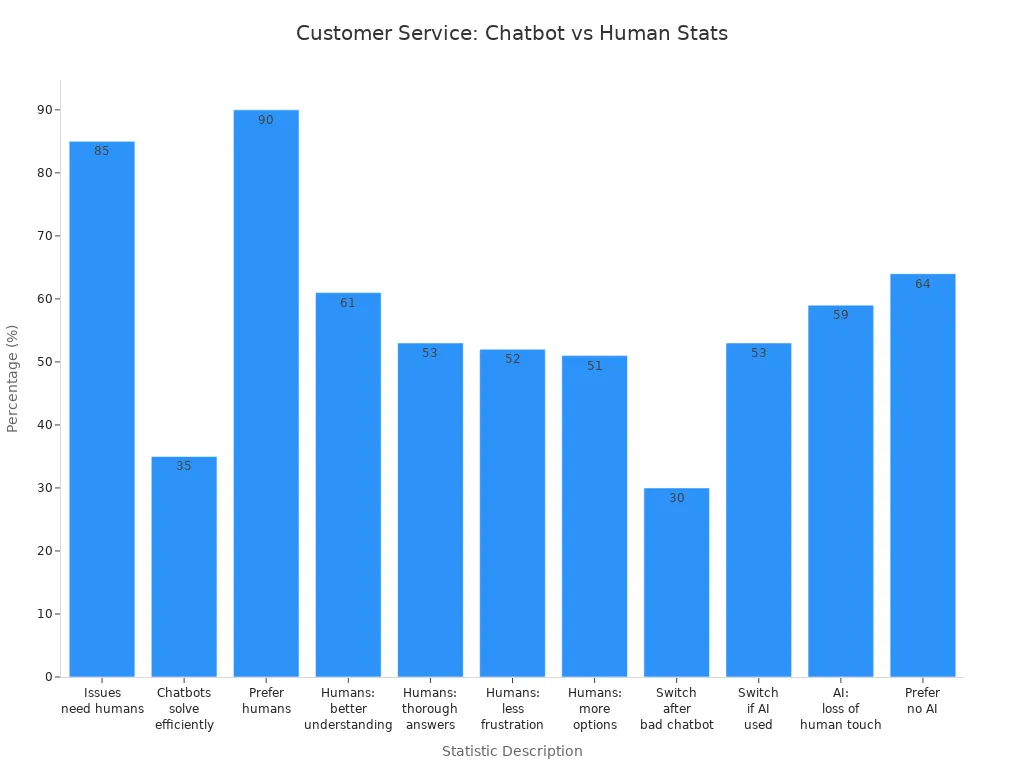
Many companies now use hybrid models, combining chatbots like the Sobot AI with human agents to balance efficiency and personal touch. When considering the avantages and disadvantage of chatbots, Sobot’s hybrid solutions help modern businesses deliver better service by leveraging the strengths of both technology and human interaction.
Chatbots in Customer Service

What Are Chatbots?
Chatbots are computer programs that use artificial intelligence to simulate conversations with people. Many businesses use chatbots to answer questions, solve problems, and guide customers through simple tasks. These ai chatbots can work on websites, apps, and messaging platforms. They help companies provide instant answers and support, even outside normal business hours. Chatbots use automation to handle many requests at once, making them a popular choice for customer support in industries like retail, banking, and healthcare.
Sobot Chatbot Overview
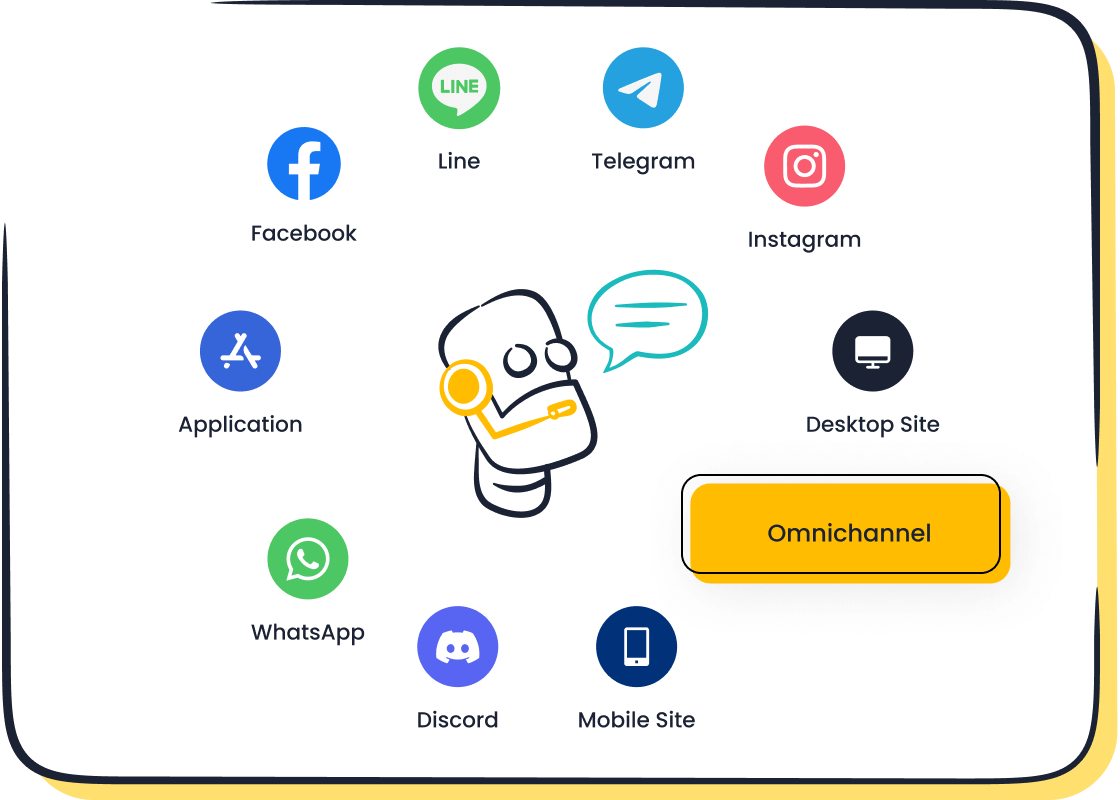
Sobot offers an advanced ai-powered chatbot designed to improve customer service for businesses of all sizes. The Sobot AI Chatbot stands out because it supports multiple languages and works across many channels, including WhatsApp, SMS, and live chat. Companies can set up the chatbot without any coding, thanks to its easy point-and-click interface. Sobot’s chatbot uses a smart knowledge base to give fast, accurate answers. It helps businesses save money by handling routine questions and letting human agents focus on more complex issues. For example, OPPO used Sobot’s chatbot to reach an 83% resolution rate and a 94% positive feedback score during busy shopping seasons.
Common Uses
Businesses in many industries rely on chatbots and ai chatbots for a variety of tasks:
- Retail and ecommerce companies use chatbots for order tracking and product recommendations.
- Banks and financial services use ai chatbots to answer account questions and help with transactions.
- Healthcare providers use chatbots to schedule appointments and share health tips.
- Travel and hospitality companies use chatbots to confirm bookings and answer travel questions.
- Media, entertainment, and utilities companies use chatbots to provide 24/7 customer support.
Chatbots offer instant responses, handle repetitive tasks, and support customers in their preferred language. Research shows that 72% of customers prefer to communicate in their native language, which leads to higher satisfaction and loyalty. Omnichannel chatbots like Sobot’s allow customers to switch between channels without repeating information, making the experience smooth and consistent. This approach helps businesses build trust and keep customers coming back.
Advantages and Disadvantage of Chatbots
24/7 Availability
One of the biggest advantages of chatbots is their 24/7 availability. Unlike human agents, chatbots never need breaks or sleep. They can answer questions and solve problems at any time, day or night. This availability around the clock means customers get help when they need it, even outside regular business hours. Research shows that 82% of consumers expect immediate responses, but the average response time for human agents is about 2 minutes. In contrast, AI chatbots like Sobot’s respond in less than 5 seconds, providing real-time responses and improving customer satisfaction. This constant support helps businesses avoid losing sales due to slow replies and keeps customers happy.
| Agent Type | Average Response Time |
|---|---|
| AI Chatbots | Less than 5 seconds |
| Human Agents | Around 2 minutes |
Tip: Companies using Sobot’s AI Chatbot can offer support to customers worldwide, no matter the time zone.
Efficiency and Cost Savings
Chatbots bring major cost efficiency to customer service. They handle routine questions and tasks, which reduces the need for extra staff. Businesses can save around 30% on support costs each year by using chatbots. For example, a company might save $300,000 annually by letting chatbots manage simple requests. Human agents cost about $110,000 per year, while a chatbot subscription costs only $300–$500 per month. Sobot’s AI Chatbot boosts productivity by 70% and helps companies cut expenses by up to 50%. Chatbots also reduce training costs and human error, making operations smoother and more reliable.
- Chatbots handle many interactions at once, unlike humans who can only help one customer at a time.
- Companies report saving thousands of dollars each month by shifting routine work to chatbots.
- Sobot’s chatbot helps businesses get 30% more leads while lowering service costs.
Scalability
A key advantage of chatbots is their scalable nature. Chatbots can handle thousands of customer conversations at the same time without extra cost. Human agents can only manage one customer at a time, which limits how many people they can help. During busy times, like holiday sales, chatbots keep up with high demand and prevent long wait times. Sobot’s AI Chatbot supports omnichannel communication, so customers can reach out on WhatsApp, SMS, or live chat and get instant help. This scalability makes chatbots ideal for growing businesses that want to serve more customers without hiring more staff.
Note: In industries like e-commerce and telecommunications, advanced chatbots resolve up to 80% of customer inquiries without human help.
Limitations in Complex Cases
Despite many advantages, chatbots have some disadvantages. They often struggle with complex queries or situations that need deep understanding or empathy. Chatbots may misunderstand nuanced language or fail to solve problems that require creative thinking. When chatbots cannot resolve an issue, they escalate the conversation to a human agent. This can cause frustration if the handoff is not smooth. Regularly updating the chatbot’s knowledge base and using customer feedback helps reduce these problems. Sobot’s AI Chatbot uses advanced technology to handle many common issues, but human agents remain essential for sensitive or complicated cases.
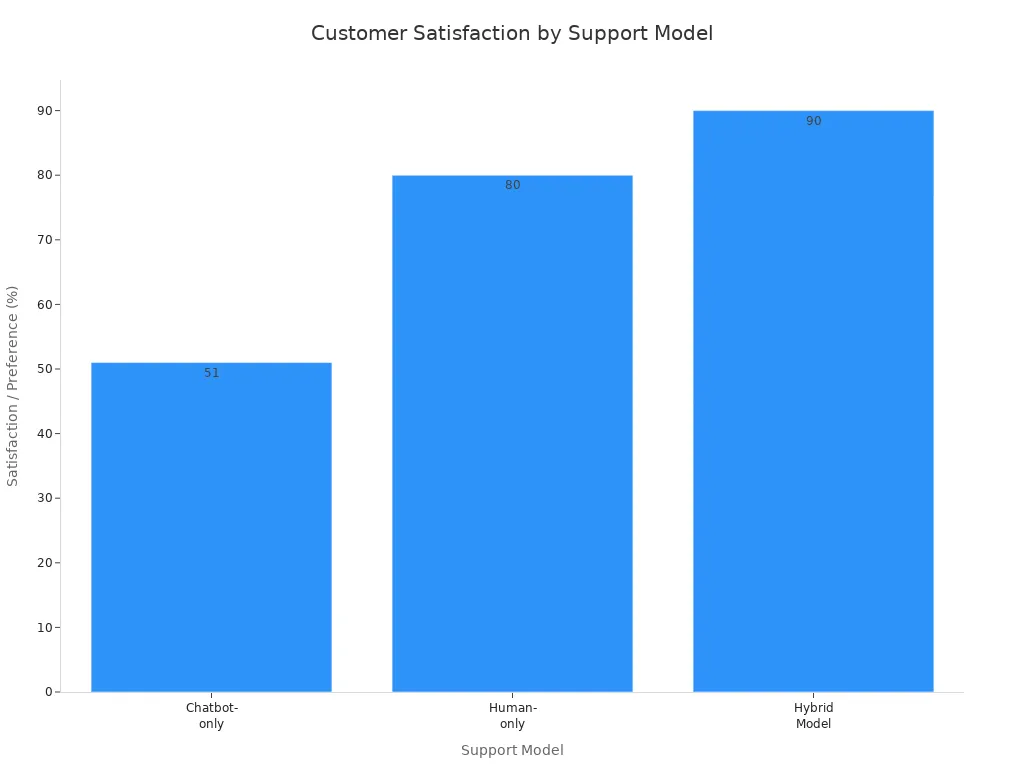
Hybrid models, where chatbots handle routine tasks and humans manage complex queries, achieve the highest customer satisfaction.
The avantages and disadvantage of chatbots depend on how businesses use them. Chatbots excel at handling queries quickly, saving money, and providing availability around the clock. However, their disadvantages include difficulty with complex or emotional issues. By combining chatbots with human agents, companies can balance speed, cost, and quality in customer service.
Human Agents
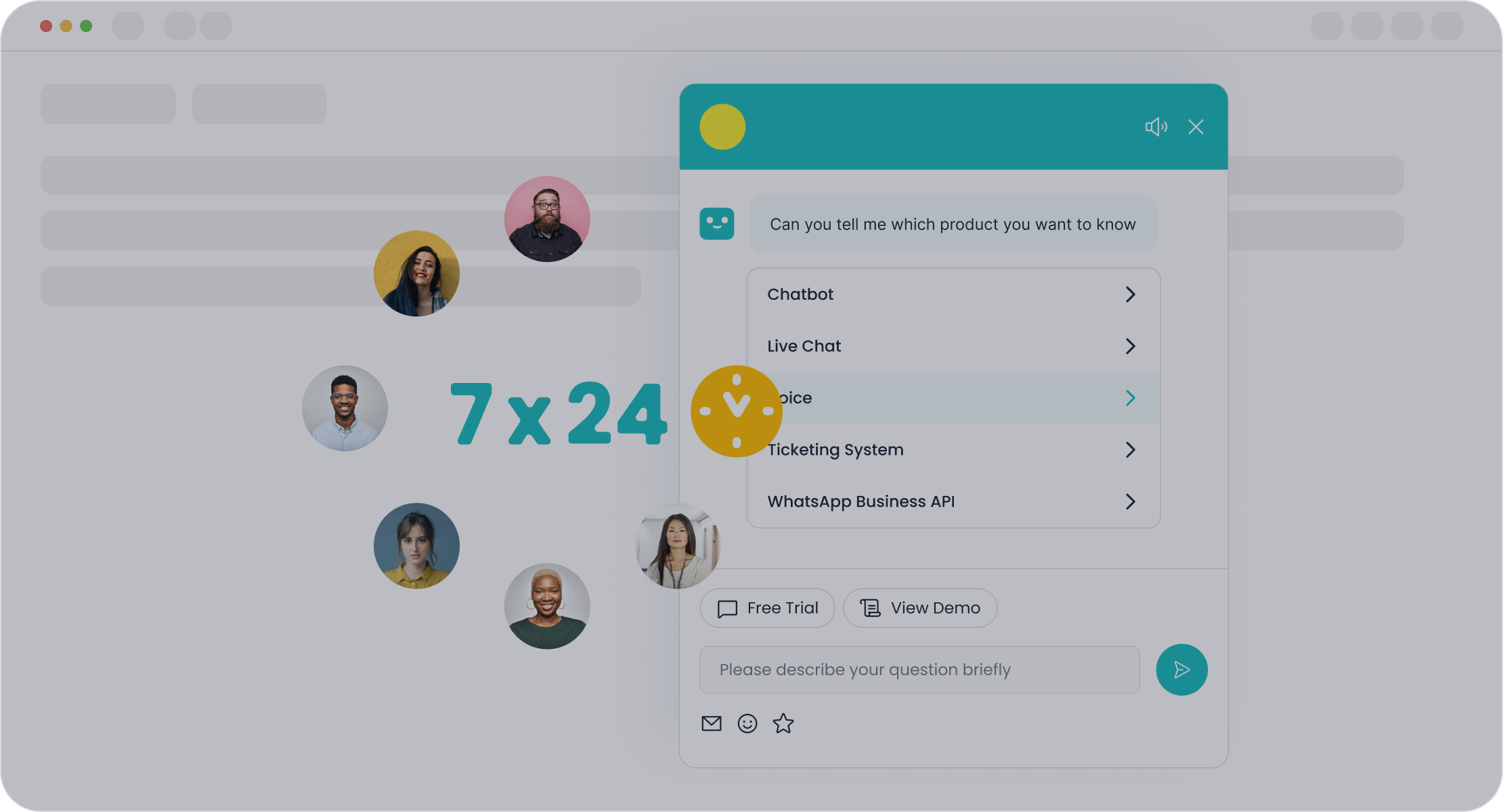
Empathy and Personalization
Human agents play a unique role in customer service. They can empathize with customers, listen to their concerns, and respond with understanding. Studies show that 75% of customers prefer human interaction, especially when they face complex or sensitive issues. Human agents use emotional intelligence to read vocal tones and cultural cues, which helps them build personal connections. This ability leads to better personalization, as agents can adapt their responses to each customer’s needs. Research from Harvard Business School shows that removing human contact in stressful situations lowers customer satisfaction. Human agents increase satisfaction by 35% and improve first call resolution by 20% because they can offer empathy and trust that AI cannot match. Source: Apizee
Complex Problem Solving
Human agents excel at solving complex problems. They use human judgment and creativity to find solutions that chatbots cannot handle. When customers face unique or emotionally charged issues, human agents can de-escalate tense situations and provide support. They detect subtle changes in tone and adjust their approach. This skill is essential for cases that require more than simple answers. While chatbots handle routine tasks, human agents remain indispensable for sensitive interactions and advanced problem-solving. A hybrid approach, like Sobot’s omnichannel solution, combines AI efficiency with the empathy of human agents for the best results.
| Aspect | Human Agents | Chatbots |
|---|---|---|
| Emotional Intelligence | High: Can read emotions and empathize | Low: Limited emotional response |
| Complex Problem Solving | Excellent: Use judgment and creativity | Poor: Struggle with unique problems |
| Personalization | High: Tailored responses | Moderate: Based on data only |
| Customer Satisfaction | High: Empathetic and personal | Moderate: Efficient but less satisfying |
Limitations and Costs
Human agents offer many benefits, but they also have some limitations. The average operational cost per customer interaction for human agents is about $5 to $7, while AI chatbots lower this to $0.25 to $0.50. Human agents require salaries, training, and management, which increases costs. They also have slower response times, with customers waiting about 45 seconds to reach a live agent. In contrast, chatbots respond in under five seconds. Despite these challenges, human agents are still necessary for complex and emotional cases where personalization and empathy matter most. Businesses like Sobot help companies balance these factors by offering solutions that combine the strengths of both human agents and AI chatbots.
Hybrid Approach
Combining Chatbots and Human Agents
A hybrid approach blends the strengths of chatbots and human agents to deliver an optimal customer service experience. Many companies now use this model to automate simple tasks while reserving complex or sensitive cases for skilled staff. Studies show that a mid-sized e-commerce company using a hybrid model saw a 25% increase in customer satisfaction, a 60% drop in response times, and a 35% rise in agent job satisfaction. The hybrid system lets chatbots handle routine questions like password resets, freeing human agents to focus on unique or emotional issues. This balance improves efficiency, reduces agent turnover, and creates exceptional customer experiences.
Sobot Omnichannel Solution
Sobot’s omnichannel solution makes the hybrid model easy to use. The platform uses advanced natural language processing to understand customer questions and machine learning to improve over time. Customers can switch between email, chat, social media, and voice without repeating themselves or losing context. Sobot’s intelligent routing sends each inquiry to the right department or human agent quickly. The system also offers real-time analytics and a unified workspace, helping teams deliver consistent and exceptional customer experiences. Sobot’s tools reduce the workload for human agents and support smooth handoffs between chatbots and staff.
Note: Sobot’s omnichannel solution integrates with existing business systems, making transitions between AI and human agents seamless.
Real-World Example: OPPO
OPPO, a global smart device leader, chose Sobot’s hybrid solution to manage high volumes of customer inquiries. During peak shopping periods, OPPO’s chatbots resolved 83% of questions, while human agents handled more complex cases. This approach led to a 94% positive feedback rate and a 57% increase in repurchase rates. Sobot’s system also helped OPPO reduce knowledge base maintenance by 90%. By combining automation with personal support, OPPO achieved higher efficiency and customer satisfaction.
Choosing the Right Solution
Assessing Business Needs
Every business has unique goals and challenges. Before choosing between chatbots, human agents, or a hybrid approach, leaders should review their main objectives. Some companies want to improve customer support speed, while others focus on cost savings or better data analytics. Industry requirements also matter. For example, healthcare companies need strong privacy controls, while e-commerce brands may need more personalization. Understanding customer needs and communication preferences helps companies pick the right tools. Sobot offers flexible solutions for many industries, making it easier to match technology with business goals.
Tip: Aligning your choice with business objectives and customer expectations leads to better results.
Support Complexity
The complexity of customer questions plays a big role in choosing the right solution. Chatbots work best for simple, routine tasks like order tracking or password resets. They can handle up to 80% of these cases quickly and accurately. However, when customers have complex or emotional issues, human agents provide the empathy and creative problem-solving needed. A hybrid model lets chatbots manage easy questions, while human agents focus on the remaining 20% of complex cases. This approach ensures both efficiency and high quality in customer support. Sobot’s omnichannel platform helps businesses switch smoothly between chatbots and agents, so customers always get the right level of help.
Cost vs. Quality
Businesses often face a trade-off between cost and quality. Chatbots can save over 30% on support costs and scale easily, but some customers still prefer the personal touch of a human agent. The best strategy is to focus on the features that matter most to your customers, like fast response times and issue resolution. By understanding what customers value, companies can deliver high quality and accuracy without overspending. Sobot’s solutions help businesses maintain this balance by automating routine tasks and letting agents handle more important issues. This method supports both cost savings and excellent service quality.
| Factor | Chatbots | Human Agents | Hybrid Approach |
|---|---|---|---|
| Cost-efficiency | Can save over 30% on customer support costs; handle multiple customers simultaneously | Limited by number of agents; higher labor costs | Combines cost savings of bots with human expertise where needed |
| Availability | Operate 24×7 without breaks; instant responses | Limited to working hours; slower response times | Ensures round-the-clock service with human backup for complex issues |
| Scalability | Easily scalable; can be adapted for multiple languages and locations | Limited scalability due to human resource constraints | Scalable automation with human intervention for complex or sensitive cases |
| Training & Improvement | Learns continuously via machine learning; no retraining costs | Requires ongoing, costly training and re-training | Bots handle routine queries; humans focus on complex training and escalation |
| Handling Complexity | Best for routine, simple queries; falters with complex or unprogrammed instructions | Excels at complex, nuanced conversations; provides empathy and emotional support | Bots manage simple queries; humans handle complex, emotional, or critical issues |
| Customer Preference | Preferred by some demographics for ease of use | Many customers desire human interaction for empathy and understanding | Balances automation efficiency with human touch to meet diverse customer expectations |
Implementation Steps
Medium-sized businesses can follow a clear process to set up a hybrid customer support solution:
- Assess current processes and find areas that need improvement.
- Create a strategy to boost efficiency across all departments.
- Research and test software that fits the hybrid model.
- Integrate new tools with existing systems.
- Train staff on new workflows and technology.
- Set up regular reviews to track progress and maintain quality.
- Monitor key performance indicators and report results to leadership.
Sobot supports companies through each step, offering easy integration and ongoing support. By following these steps, businesses can achieve streamlined operations and high customer satisfaction, striking the right balance between cost and service quality.
Chatbots deliver speed, cost savings, and 24/7 customer service, while human agents excel in empathy and complex problem-solving. Studies show hybrid models, like Sobot’s omnichannel platform, reduce response times by 37% and boost satisfaction. Businesses should assess their needs and consider a hybrid approach for optimal results.
Sobot’s AI Chatbot and omnichannel solutions help companies balance efficiency, quality, and personalization.
Explore Sobot’s offerings to transform your customer service: www.sobot.io.
FAQ
What are the main benefits of using chatbots in customer service?
Chatbots provide 24/7 support, instant responses, and cost savings. Sobot’s AI chatbot can handle thousands of customer service requests at once. Businesses using chatbots report up to 70% higher productivity and 50% lower support costs.
When should a business use human agents instead of chatbots?
Human agents work best for complex, sensitive, or emotional customer service cases. They use empathy and creative problem-solving. For example, 75% of customers prefer human agents for difficult issues that chatbots cannot solve.
How does Sobot’s AI chatbot improve customer satisfaction?
Sobot’s AI chatbot offers multilingual support, omnichannel communication, and instant answers. OPPO used Sobot’s chatbot to achieve an 83% resolution rate and a 94% positive feedback score. This shows how chatbots can boost customer satisfaction and loyalty.
Can chatbots and human agents work together in customer service?
Yes! Many companies use a hybrid model. Chatbots handle routine questions, while human agents solve complex problems. Sobot’s omnichannel solution lets chatbots and human agents work together, improving efficiency and customer experience.
How can a business choose between chatbots, human agents, or a hybrid approach?
Businesses should consider customer needs, support complexity, and cost. Chatbots work well for simple tasks. Human agents handle complex cases. Sobot’s hybrid solutions help companies balance efficiency, quality, and customer satisfaction in customer service.
See Also
Key Advantages of Using Chatbots On Websites
How To Select The Ideal Chatbot Software
Simple Steps To Add Chatbot Examples On Websites
